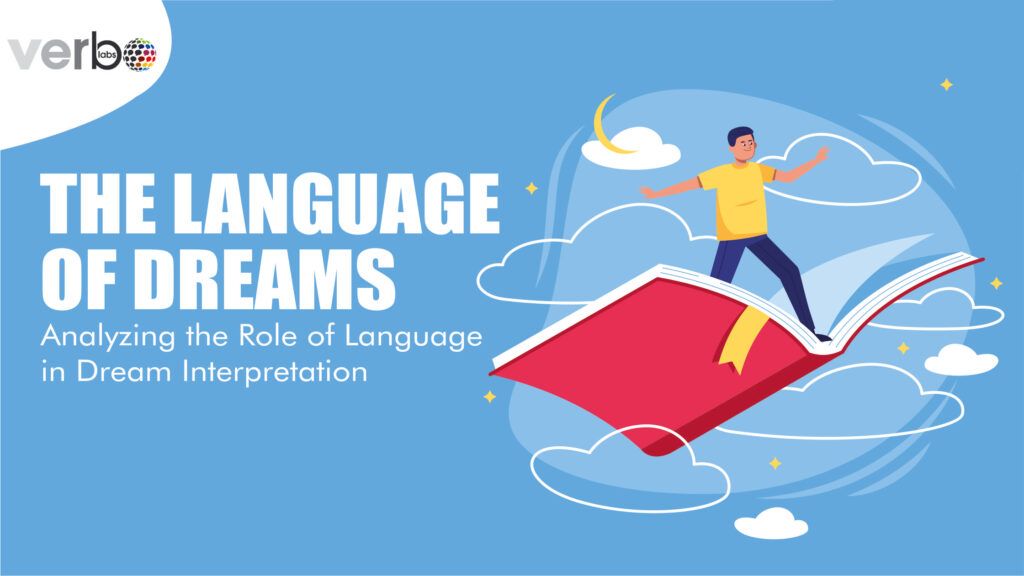Dreams have long fascinated and intrigued humankind, serving as a gateway to the unchartered territories of the subconscious mind. It is only fair to indulge the humane curiosity about it and explore the profound relationship between language and dreams. Understanding how language influences our dreams can allow us insights into how we can harness it to interpret their meanings. By analyzing the role of language in dream interpretation, we can gain a deeper understanding of the connections between our waking and dreaming selves.
The Interpretation of Dreams, published in 1899, is often cited as the beginning of psychoanalytic theory. Sigmund Freud is universally regarded as the “father” of psychoanalysis. Freud uses his dreams as examples throughout The Interpretation of Dreams to support his new theory regarding the psychology of dreams. As opposed to the “manifest,” or surface-level, dream content, Freud distinguished between the “latent,” or unconscious, “dream thoughts” that were conveyed through the distinctive “language” of dreams. He believes that even anxious dreams and nightmares are manifestations of unconscious desires. What appears to be irrelevant gibberish in a dream can, via the process of analysis, be proven to express a coherent collection of thoughts, according to Freud, who claims that the act of “censorship” in dreams creates a “distortion” of the dream content. The process by which the mind warps and converts “dream thoughts” into dream content is known as “dream work.” According to Freud, dream analysis may have the greatest utility when it reveals the unconscious mind’s hidden processes. But at the core of it, all lies language, and one can’t exist without another.
- The Language of Dreams: Communication and Expression
Language undoubtedly, plays a fundamental role in our dreams, enabling communication, expression, and symbolism within the dream world. Although dreams seldom follow logic and reason, they are not devoid of language. Instead, dream language tends to be fluid, malleable, and sometimes nonsensical. It reflects the imaginative nature of our subconscious minds. Language can take various forms in dreams, including conversations with dream characters, written messages, or internal monologues. Using language, we can navigate the murky waters of our inner world and dive into the depths of our emotions, desires, and struggles. The creative ability of dream language offers a means to express complex thoughts that slips into our waking language and convey the things we wouldn’t even accept that we’re thinking to begin with.
- Language as a Tool for Dream Recall
Recalling dreams is crucial for their analysis and interpretation. Language plays a vital role in dream recall, as translating our dream experiences into words helps solidify memories and makes them easier to analyse later. Maintaining a dream journal, where dreams are recorded upon awakening, is an effective technique for improving dream recall. Using language to describe our dreams establishes a connection between the conscious and unconscious minds. Transforming dreams into words brings them into the realm of our waking awareness, enabling us to revisit their details, emotions, and imagery. This process provides a foundation for deeper analysis and interpretation, allowing us to unravel the intricate layers of symbolism and meaning that reside within our dreams. As we engage in the act of writing, we bridge the gap between the ephemeral nature of dreams and the tangible reality of our waking lives, giving shape and substance to the ethereal world of dreams through the power of language.
- Symbolism and Metaphor in Dream Language
Dreams often employ symbolism and metaphor to convey emotions, conflicts, and desires, creating a rich tapestry of meaning within the dream narrative. However, the interpretation of these symbols is subjective and deeply influenced by personal associations. For example, a snake in a dream might represent fear for one person, symbolizing a threat or danger. In contrast, for another person, it may symbolize transformation or healing, representing a positive change. Understanding dream symbols requires careful consideration of context and individual experiences. Factors such as the dreamer’s personal history, cultural background, and current life circumstances shape the symbolic meanings attached to various elements within the dream. By analyzing the language used in dreams, we can unravel the underlying symbolism and gain valuable insights into the emotions and conflicts they represent, ultimately deepening our understanding of ourselves and our inner world.
- Linguistic Patterns and Dream Analysis
Dreams frequently exhibit linguistic patterns that offer further insights into their meanings. These patterns may include recurring words or phrases, specific themes, or even the tone of the dream. By examining linguistic patterns, we can uncover deeper layers of symbolism and significance within the dream. Analyzing the word choices, emotional undertones, and language patterns can help decipher the dream’s message. For instance, repeating a particular word or phrase throughout different dreams may indicate an unresolved issue or a recurring thought in the dreamer’s life. Emotional undertones expressed through language can provide clues about the dreamer’s unconscious desires, fears, unresolved conflicts, or even hidden aspirations. These linguistic patterns act as breadcrumbs, guiding us toward a deeper understanding of ourselves and the messages our dreams are trying to convey. By paying attention to the subtleties of dream language, we can gain valuable insights into our inner world and the intricate workings of our subconscious mind.
- Language and Lucid Dreaming
Lucid dreaming introduces an additional dimension to the role of language in dreams, expanding the possibilities of communication, manifestation, and self-reflection. When a dreamer becomes aware that they are dreaming, they enter a state of lucidity that allows them to consciously navigate and interact within the dream world. In this heightened state of awareness, language becomes a powerful tool for intentional exploration and self-discovery. Within lucid dreams, the dreamer can engage in conversations with dream characters, transforming the dream into a dynamic interactive experience. They can initiate dialogue, ask questions, and receive responses from the dream characters, creating a unique opportunity for communication and self-expression. This exchange of language within the dream can provide insights into the dreamer’s subconscious thoughts, desires, and conflicts.
Also, language in lucid dreams enables the dreamer to deliberately manipulate the dream environment. By using language to command and shape the dream narrative, the dreamer can alter the dream scenery, summon objects, or even change the course of events. This ability to manifest through language within the dream allows for a sense of empowerment and control, providing a platform for personal exploration and experimentation. Language also plays a crucial role in personal introspection during lucid dreams. The dreamer can self-reflect through inner dialogue, contemplating their thoughts, emotions, and motivations. This internal conversation can lead to profound insights and self-awareness as the dreamer explores their inner landscape and delves into the depths of their subconscious mind. Language becomes a vehicle for self-exploration and self-discovery within the lucid dream state. Through conversations with dream characters, intentional manipulation of the dream environment, and inner dialogue, language becomes a powerful tool for communication, manifestation, and self-reflection within the lucid dream world. Lucid dreaming opens up a realm of intentional exploration and self-discovery, where language becomes a bridge between the conscious and subconscious mind, enabling the dreamer to shape their dream experiences and gain profound insights into themselves.
Conclusion
The language of dreams is a captivating and multifaceted aspect of the human experience. It serves as a profound vehicle for communication, expression, and symbolism within the vast realm of the subconscious mind. Through the analysis of the role of language in dream interpretation, we embark on a transformative journey, unraveling the hidden meanings embedded within our dreams and gaining a deeper understanding of ourselves. Language in dreams allows for the expression of complex emotions that may elude us in our waking lives. Dreams provide a safe space where we can explore and release our deepest desires, fears, and conflicts through the symbolic language of the subconscious. Within the dream realm, we can freely navigate the intricacies of our innermost thoughts and emotions, utilizing language as a conduit for their expression.
Additionally, dreams offer a unique opportunity to explore symbolism and metaphor. The symbolic language employed in dreams enables us to communicate in abstract and metaphorical terms, painting vivid images that represent our subconscious experiences. By deciphering these symbols and uncovering their significance, we gain invaluable insights into our inner landscape and the layers of meaning within our dreams. Dream recall and journaling become paramount to bridging the gap between the dream world and our waking consciousness. By capturing our dreams in written form, we bring them into our waking awareness, solidifying their memory and providing a foundation for analysis and interpretation. Dream recall and journaling serve as a conduit through which we can actively explore the language of our dreams, fostering a deeper connection between our conscious and subconscious minds.



